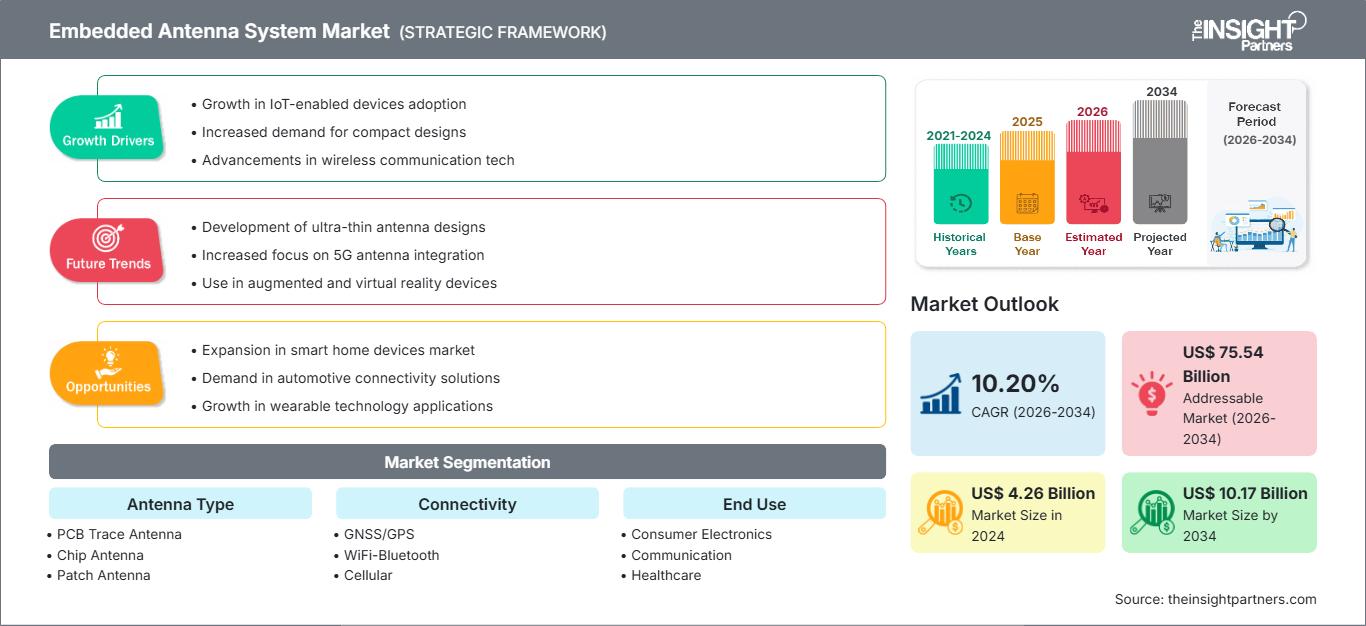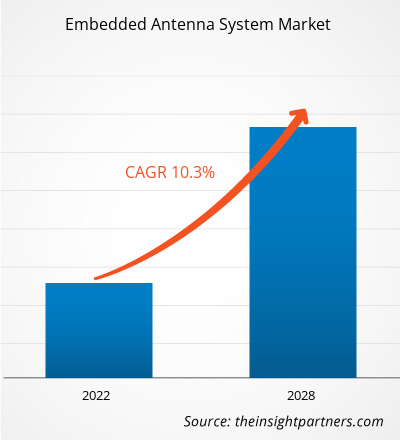Der Markt für eingebettete Antennensysteme wird bis 2034 voraussichtlich ein Volumen von 10,17 Milliarden US-Dollar erreichen, gegenüber 4,26 Milliarden US-Dollar im Jahr 2024. Es wird erwartet, dass der Markt im Zeitraum 2026–2034 eine durchschnittliche jährliche Wachstumsrate (CAGR) von 10,20 % verzeichnen wird.
Marktanalyse für eingebettete Antennensysteme
Der Markt für eingebettete Antennensysteme verzeichnet ein starkes Wachstum aufgrund der steigenden Nachfrage nach kompakten, integrierten Antennen in drahtlosen Geräten. Zu den Wachstumstreibern zählen die zunehmende Verbreitung von IoT-Geräten, der rasche Ausbau von 5G-Netzen, der leistungsstarke Multiband-Antennen erfordert, und die fortschreitende Miniaturisierung in der Unterhaltungselektronik. Eingebettete Antennen sind für Anwendungen in Smartphones, Wearables, vernetzten Fahrzeugen, industriellen IoT-Sensoren und weiteren Bereichen unerlässlich. Beispielsweise integriert die Automobilindustrie zunehmend eingebettete Antennen für die V2X-Kommunikation, GPS und die Fahrzeugvernetzung.
Marktübersicht für eingebettete Antennensysteme
Eingebettete Antennensysteme sind winzige, integrierte Antennen, die für den Einbau in elektronische Geräte konzipiert sind und eine nahtlose drahtlose Kommunikation ermöglichen. Im Gegensatz zu externen Antennen sparen eingebettete Lösungen Platz, reduzieren die Komplexität der Produktion und verbessern die Zuverlässigkeit, da sie Teil der Leiterplatte oder der Gerätestruktur sind. Diese Systeme sind in modernen Geräten besonders wertvoll, da sie mehrere Kommunikationsstandards (z. B. WLAN/Bluetooth, Mobilfunk einschließlich 5G, GNSS), MIMO-Konfigurationen und die Fähigkeit zur intelligenten Anpassung unterstützen.
Passen Sie diesen Bericht Ihren Anforderungen an.
Sie erhalten eine kostenlose Anpassung aller Berichte – einschließlich Teilen dieses Berichts, Länderanalysen und Excel-Datenpaketen – sowie attraktive Angebote und Rabatte für Start-ups und Universitäten.
Markt für eingebettete Antennensysteme: Strategische Einblicke

-
Ermitteln Sie die wichtigsten Markttrends dieses Berichts.Diese KOSTENLOSE Probe beinhaltet eine Datenanalyse, die von Markttrends bis hin zu Schätzungen und Prognosen reicht.
Markttreiber und Chancen für eingebettete Antennensysteme
Markttreiber:
- 5G-Einführung: Die weltweite Einführung von 5G (einschließlich Sub-6-GHz- und Millimeterwellenbändern) ist ein wichtiger Katalysator und treibt die Nachfrage nach fortschrittlichen eingebetteten Antennen an, die in der Lage sind, hohe Frequenzen zu verarbeiten und Beamforming zu ermöglichen.
- IoT-Verbreitung: Die explosionsartige Zunahme von IoT-Geräten – von Wearables bis hin zu industriellen Sensoren – erfordert kompakte, energieeffiziente und leistungsstarke Antennenlösungen.
- Miniaturisierungsbedarf: Mit der Miniaturisierung elektronischer Geräte steigt der Bedarf an Antennen mit kleinem Formfaktor. Eingebettete Antennen gewährleisten zuverlässige Verbindungen, ohne externen Platz zu beanspruchen.
Marktchancen:
- Flexible / Konforme Antennen: FPC-Antennen (Flexible Printed Circuit) gewinnen aufgrund ihrer Flexibilität und der Fähigkeit, sich an unterschiedliche Geräteformen anzupassen, zunehmend an Bedeutung.
- Automotive Connectivity: Mit vernetzten Fahrzeugen, ADAS, V2X und autonomem Fahren werden eingebettete Antennen zunehmend in Automobile integriert.
- Industrielles IoT & Gesundheitswesen: Der Einsatz in industriellen Sensoren und medizinischer Telemetrie eröffnet neue Anwendungsfälle, insbesondere dort, wo Antennengröße und Zuverlässigkeit von entscheidender Bedeutung sind.
Marktbericht: Segmentierungsanalyse für eingebettete Antennensysteme
Der Marktanteil eingebetteter Antennensysteme wird in verschiedenen Segmenten analysiert, um ein besseres Verständnis seiner Struktur, seines Wachstumspotenzials und der aufkommenden Trends zu ermöglichen. Nachfolgend ist der in den meisten Branchenberichten verwendete Standard-Segmentierungsansatz dargestellt:
Nach Antennentyp:
- Leiterplattenantenne
- Chipantenne
- Patchantenne
- Flexible Leiterplattenantenne
Nach Konnektivität:
- GNSS/GPS
- WLAN-Bluetooth
- Mobilfunk
- mmWelle
- LPWAn
- RFID
- UWB
Nach Endverwendung:
- Unterhaltungselektronik
- Kommunikation
- Gesundheitspflege
- Luft- und Raumfahrt & Verteidigung
- Industrie
- Automobil & Transport
Nach Geografie / Region:
- Nordamerika
- Europa
- Asien-Pazifik
- Lateinamerika
- Naher Osten und Afrika
Markt für eingebettete Antennensysteme – Regionale Einblicke
Die regionalen Trends und Einflussfaktoren auf den Markt für eingebettete Antennensysteme im gesamten Prognosezeitraum wurden von den Analysten von The Insight Partners eingehend erläutert. Dieser Abschnitt behandelt außerdem die Marktsegmente und die geografische Verteilung des Marktes für eingebettete Antennensysteme in Nordamerika, Europa, Asien-Pazifik, dem Nahen Osten und Afrika sowie Süd- und Mittelamerika.
Berichtsumfang zum Markt für eingebettete Antennensysteme
| Berichtattribute | Details |
|---|---|
| Marktgröße im Jahr 2024 | 4,26 Milliarden US-Dollar |
| Marktgröße bis 2034 | 10,17 Milliarden US-Dollar |
| Globale durchschnittliche jährliche Wachstumsrate (2026 - 2034) | 10,20 % |
| Historische Daten | 2021-2024 |
| Prognosezeitraum | 2026–2034 |
| Abgedeckte Segmente |
Nach Antennentyp
|
| Abgedeckte Regionen und Länder |
Nordamerika
|
| Marktführer und wichtige Unternehmensprofile |
|
Marktdichte der Akteure im Markt für eingebettete Antennensysteme: Auswirkungen auf die Geschäftsdynamik verstehen
Der Markt für eingebettete Antennensysteme wächst rasant, angetrieben durch die steigende Nachfrage der Endnutzer. Gründe hierfür sind unter anderem sich wandelnde Verbraucherpräferenzen, technologische Fortschritte und ein wachsendes Bewusstsein für die Vorteile des Produkts. Mit steigender Nachfrage erweitern Unternehmen ihr Angebot, entwickeln innovative Lösungen, um den Kundenbedürfnissen gerecht zu werden, und nutzen neue Trends, was das Marktwachstum zusätzlich beflügelt.

- Verschaffen Sie sich einen Überblick über die wichtigsten Akteure im Markt für eingebettete Antennensysteme.
Marktanteilsanalyse für eingebettete Antennensysteme nach Regionen
Der nordamerikanische Markt profitiert von starken technologischen Fortschritten, der weitverbreiteten Nutzung des Internets der Dinge (IoT) und der steigenden Nachfrage nach drahtloser Kommunikation in Branchen wie der Automobilindustrie, der Verteidigungsindustrie und dem Gesundheitswesen. Der asiatisch-pazifische Raum ist die am schnellsten wachsende Region im Prognosezeitraum. Treiber dieses Wachstums sind die rasche Industrialisierung, die steigende Produktion von Unterhaltungselektronik und der Ausbau der Telekommunikationsinfrastruktur, insbesondere in Ländern wie China, Indien und Japan.
Der Markt für eingebettete Antennensysteme weist aufgrund von Faktoren wie der Expansion des Internets der Dinge (IoT) und intelligenter Geräte in den einzelnen Regionen unterschiedliche Wachstumsverläufe auf. Nachfolgend finden Sie eine Zusammenfassung der Marktanteile und Trends nach Regionen:
Nordamerika
- Marktanteil: Der Markt für eingebettete Antennensysteme profitiert von starken technologischen Fortschritten, der weitverbreiteten Nutzung des Internets der Dinge (IoT) und der steigenden Nachfrage nach drahtloser Kommunikation in Branchen wie der Automobilindustrie, der Verteidigungsindustrie und dem Gesundheitswesen.
-
Wichtigste Einflussfaktoren:
- Starke Akzeptanz in den Bereichen Unterhaltungselektronik, industrielles IoT und Automobilvernetzung.
- Schneller 5G-Ausbau und fortschrittliche Telekommunikationsinfrastruktur.
- Hohe Integration eingebetteter Antennen in tragbare Geräte, Telematiksysteme und V2X-Systeme, unterstützt durch eine bedeutende Forschungs- und Entwicklungspräsenz in den USA und Kanada.
- Trends: Anhaltende Nachfrage nach Miniaturisierung, Mehrbandantennen und energieeffizienten IoT-Modulen.
Europa
- Marktanteil: Erhebliche Nachfrage, getrieben von Hightech-Industrien und vernetzter Infrastruktur.
-
Wichtigste Einflussfaktoren:
- Starke Akzeptanz in den Bereichen Automobilanwendungen (vernetzte Fahrzeuge, Telematik) und industrielle Automatisierung.
- Regulatorischer Druck für Konnektivitätsstandards, Einhaltung von Sicherheitsstandards und digitale Transformation (z. B. in intelligenten Fabriken).
- Trends: Wachstum in den Bereichen intelligente Fertigung, Telemedizin und eingebettete Antennen für intelligente Automobilmodule.
Asien-Pazifik (APAC)
- Marktanteil: Voraussichtlich die am schnellsten wachsende Region aufgrund der großen Elektronikfertigung in China, Taiwan und Südkorea.
-
Wichtigste Einflussfaktoren:
- Großserienfertigung von Unterhaltungselektronik.
- Umfangreicher 5G-Ausbau und staatlich geförderte Smart-City-/IoT-Initiativen.
- Rasante Industrialisierung und starke Nachfrage nach eingebetteten Lösungen in Automobilen und tragbaren Geräten.
- Trends: Massenproduktion von eingebetteten Antennen, zunehmender Einsatz in Elektrofahrzeugen und intelligenten Geräten sowie verstärkte Lokalisierung von Design und Fertigung.
Lateinamerika (Süd- und Mittelamerika)
- Marktanteil: Aufstrebender Markt mit Wachstumspotenzial aufgrund der zunehmenden Verbreitung von Smartphones und der digitalen Modernisierung.
-
Wichtigste Einflussfaktoren:
- Steigende Smartphone-Nutzung und wachsende digitale Infrastruktur.
- Zunehmende IoT-Nutzung in Logistik, Landwirtschaft und Fertigung.
- Trends: Allmähliche Verbreitung von eingebetteten Antennen für Telematik- und Verbrauchergeräte, wobei Kostensensibilität und regulatorische Herausforderungen weiterhin bestehen.
Naher Osten und Afrika (MEA)
-
Wichtigste Einflussfaktoren:
- Investitionen in die Infrastruktur intelligenter Städte und den Ausbau von 5G, insbesondere in den Golfstaaten (z. B. VAE, Saudi-Arabien).
- Wachsende Nachfrage in den Bereichen vernetzter Transport, Gesundheitswesen und IoT.
- Trends: Partnerschaften mit globalen Technologieunternehmen, Importabhängigkeit und langsam zunehmende lokale Integration fortschrittlicher eingebetteter Antennenmodule.
Marktdichte der Akteure im Markt für eingebettete Antennensysteme: Auswirkungen auf die Geschäftsdynamik verstehen
Der Markt für eingebettete Antennensysteme ist durch den verstärkten Wettbewerb zwischen großen globalen Technologieanbietern und aufstrebenden Nischenanbietern sowie spezialisierten Startups geprägt. Unternehmen investieren aktiv in Innovationen, um ihre Marktposition zu stärken und die wachsende Nachfrage nach intelligenten Entscheidungsplattformen branchenübergreifend zu decken.
Der Wettbewerb zwingt die Anbieter dazu, sich durch Folgendes zu differenzieren:
- Innovationen bei der Miniaturisierung von Antennen (Chipantennen, flexible Antennen)
- Unterstützung mehrerer Frequenzbänder (5G, GNSS, Wi-Fi)
- Integrationsfähigkeit (OEMs wünschen sich Antennen, die sich problemlos in Leiterplatten integrieren lassen)
- Kosten- und Energieeffizienz, insbesondere für IoT-Anwendungsfälle
Chancen und strategische Schritte
- Partnerschaften: Antennenhersteller können Partnerschaften mit Smartphone-OEMs und Automobilunternehmen eingehen, um gemeinsam eingebettete Antennenmodule zu entwickeln, die auf spezifische Geräte zugeschnitten sind.
- Investitionen in Forschung und Entwicklung: Es besteht die Möglichkeit für Forschung und Entwicklung im Bereich flexibler und anpassungsfähiger Antennen für tragbare Geräte und gekrümmte Oberflächen.
- Schwellenländer: Expansion in schnell wachsende Regionen wie den asiatisch-pazifischen Raum, Lateinamerika und den Nahen Osten, wo die Akzeptanz von IoT zunimmt.
- Individualisierung: Entwicklung kundenspezifischer Antennenlösungen für spezifische Branchen (z. B. Verteidigung, Gesundheitswesen), in denen Leistung und Zuverlässigkeit von entscheidender Bedeutung sind.
Wichtige Unternehmen, die auf dem Markt für eingebettete Antennensysteme tätig sind
- Airgain, Inc
- Antenova Ltd.
- Infinite Electronics International, Inc
- Kyocera AVX Components Corporation
- Mitsubishi Materials Corporation
- MOLEX
- LINX Technologies
- TE-Konnektivität
- Walsin Technology Corporation
Marktneuigkeiten und aktuelle Entwicklungen im Bereich eingebetteter Antennensysteme
- Am 11. November 2025 gab beispielsweise Airgain, Inc., ein führender Anbieter von drahtlosen Konnektivitätslösungen, bekannt, dass er einen Designauftrag von einem weltweit führenden CPE-Hersteller für ein Wi-Fi 7 Glasfaser-Breitbandgateway der nächsten Generation erhalten hat, das für einen großen nordamerikanischen Breitbandbetreiber entwickelt wird.
- Am 30. Juli 2025 kündigte Antenova Ltd., Hersteller von Antennen und HF-Antennenmodulen für M2M und das Internet der Dinge, eine neue, integrierte GNSS-Antenne namens Sinica an, die im Satellitenfrequenzband von 1559–1609 MHz arbeitet. Diese neue Antenne nutzt ein neuartiges Design und neue Materialien, um trotz ihrer extrem flachen Bauweise eine hohe Leistung zu erzielen.
- Am 19. Juni 2025 kündigte Airgain, Inc., ein führender Anbieter von drahtlosen Verbindungslösungen, die Markteinführung des NimbeLink Skywire™ Cat 1 bis Embedded Modems an – des branchenweit ersten Plug-and-Play-Cat-1-bis-Modems für Endanwendungen im industriellen IoT. Dieses neue Modem wurde entwickelt, um die Mobilfunkintegration für eine Vielzahl von Anwendungen zu vereinfachen und stellt einen bedeutenden Fortschritt bei der Vereinfachung und Beschleunigung von IoT-Implementierungen in Industrie, Gesundheitswesen, Logistik und Smart Cities dar.
- Im April 2024 gab Infinite Electronics, ein globales Portfolio führender Marken für Konnektivitätslösungen mit Lagerverfügbarkeit, bekannt, dass es den Verkauf seiner Geschäftsbereiche KP Performance Antennas und RadioWaves an Alive Telecommunications, einen globalen Anbieter von Kommunikationsausrüstung, -systemen und -dienstleistungen, abgeschlossen hat.
Marktbericht zu eingebetteten Antennensystemen: Abdeckung und Ergebnisse
Der Bericht „Marktgröße und Prognose für eingebettete Antennensysteme (2021–2034)“ bietet eine detaillierte Analyse des Marktes und deckt folgende Bereiche ab:
- Marktgröße und Prognose für eingebettete Antennensysteme auf globaler, regionaler und Länderebene für alle wichtigen Marktsegmente, die im Rahmen des Berichts abgedeckt werden
- Markttrends für eingebettete Antennensysteme sowie Marktdynamiken wie Treiber, Hemmnisse und wichtige Chancen
- Detaillierte PEST- und SWOT-Analyse
- Marktanalyse für eingebettete Antennensysteme: Wichtige Markttrends, globale und regionale Rahmenbedingungen, Hauptakteure, regulatorische Rahmenbedingungen und aktuelle Marktentwicklungen
- Branchenlandschaft und Wettbewerbsanalyse mit Marktkonzentration, Heatmap-Analyse, führenden Anbietern und aktuellen Entwicklungen im Markt für eingebettete Antennensysteme. Detaillierte Unternehmensprofile.
- Historische Analyse (2 Jahre), Basisjahr, Prognose (7 Jahre) mit CAGR
- PEST- und SWOT-Analyse
- Marktgröße Wert/Volumen – Global, Regional, Land
- Branchen- und Wettbewerbslandschaft
- Excel-Datensatz
Aktuelle Berichte
Erfahrungsberichte
Grund zum Kauf
- Fundierte Entscheidungsfindung
- Marktdynamik verstehen
- Wettbewerbsanalyse
- Kundeneinblicke
- Marktprognosen
- Risikominimierung
- Strategische Planung
- Investitionsbegründung
- Identifizierung neuer Märkte
- Verbesserung von Marketingstrategien
- Steigerung der Betriebseffizienz
- Anpassung an regulatorische Trends






















 Kostenlose Probe anfordern für - Markt für eingebettete Antennensysteme
Kostenlose Probe anfordern für - Markt für eingebettete Antennensysteme